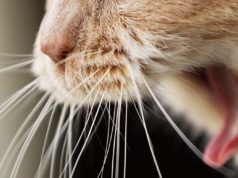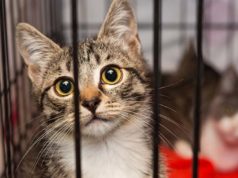What cat doesn’t like catnip? It turns out that while majority of them do, about 33% of cats will have no reaction to catnip whatsoever. For the uninitiated, catnip for cats is a type of hallucinogenic that through its main compound Nepetalactone (essential oil) affects cats in very odd ways.
Most cat owners are already familiar with the magic of catnip. We know what catnip for cats is and does, and why it’s often a good idea to have some on hand. There are many uses for this substance, and tricks pet owners can employ to train cats, entertain them, make them exercise and more.
But how much do you actually know about the famous feline drug? Here an infographic and a full list below of 20 things you probably didn’t know about catnip for cats.
20 Things You Didn’t Know About Catnip
Like this infographic? Spread the word! Share it on your site:
<p><strong>Please include attribution to CatsPhD.com with this graphic.</strong></p> <p><a href=”https://catsphd.com/catnip-for-cats/”><img src=”https://catsphd.com/wp-content/uploads/2017/09/20-Catnip-Facts.jpg” alt=”20 Things You Didn’t Know About Catnip” width=”700px” border=”0″ /></a></p>
20 Things You Didn’t Know About Catnip for Cats
1. It’s also known as
It’s an herb that most cats cannot resist. It’s not just our domesticated cats that are attracted to catnip, either. Many wild cats, such as lions, tigers, cougars and leopards love the effect of catnip.
Once a cat gets a sense of the potent herb, it will usually roll in it, rub on it, purr or even growl at it. They generally tend to go a little crazy for a short while. After about 15 minutes, they seem to lose interest.
2. Its three most popular uses are
- In a crate to help calm down a cat during a journey
- In cat toys to spike cat’s interest and excitement
- On scratching posts to encourage their use
That said, it’s not a good idea to use catnip in your cat’s litter box. It might cause your feline to get over excited and roll about in the tray. Not only will this cause a mess everywhere, there is also a risk of the cat digesting the litter. That’s an unhygienic substance and could lead to serious medical problems. If you want to encourage your cat to use the litter tray, then maybe a few drops of catnip close to the tray may be useful.
3. Humans used catnip for centuries
Catnip has been used for human consumption for years. Most commonly it’s been used in teas, herbal cigarettes and as a cooking herb. It was once believed that catnip has medicinal properties, but due to lack of evidence it’s not as common today.
4. Catnip is a mild hallucinogenic
What makes it a hallucinogenic is the way it affects the cat’s sensory system. The volatile oil called Nepetalactone goes through the feline’s nasal tissues, where it binds with the protein receptors and immediately stimulate’s the cat’s sensory neurons. The result of this is that your cat’s hypothalamus, which regulates emotions, is affected. Scientific American has a great article on the subject.
5. But it’s not addictive and is completely safe
Does this mean that we are, in effect, drugging our pet cats? Not really. Catnip has been shown to be completely safe for your cat. Whatever the effects of this odorous herb, it soon wears off. Catnip is not addictive for cats, and will not harm our feline friends.
6. It’s used elsewhere, too
 Its main chemical, Nepetalactone, is also used as mosquito repellent. It is an essential oil, and is often used elsewhere, but mostly as fly repellent. Although it is not as effective as others, such as Veet, when used on the skin.
Its main chemical, Nepetalactone, is also used as mosquito repellent. It is an essential oil, and is often used elsewhere, but mostly as fly repellent. Although it is not as effective as others, such as Veet, when used on the skin.
7. Cats never intend to eat it
Normally, cats brush against (and sometimes bite) the leaf which releases oils. When a cat bites into the leaf, they have no intention to eat it. By bruising the leaf, they release the oils of the herb, which are not poisonous or harmful in any way.
8. It doesn’t work for all cats
Studies show that not all cats are attracted to it. Those that do react to this chemical are momentarily in a state of happiness. Whether or not your cat responds to catnip could be genetically dependent.
Research shows that it could be a certain gene in the cat that reacts to the chemical. Though other studies have contested this. But, for whatever reason, around 33% of cats will not react to catnip at all.
9. Rarely, but it makes some cats aggressive
It’s been observed that some cats actually react to it in an aggressive manner and become aggregated. Much depends on their sensitivity to the chemical. Aggressiveness in cats due to catnip is rare and for most cats, it makes them playful.
10. Cat must be old enough to be affected
Cats that are not sexually active and under 6 months old do not respond to catnip. Some studies have seen kittens above 3 months to react to catnip, however, most felines will only be affected once they become sexually active (around the age of 6-12 months).
11. It works well as a training tool
Other than entertaining your cat, another great use of catnip is as a training tool. Sprinkle a little onto new bedding you have just introduced your feline to. As suggested earlier, rub it on the cat’s scratching post or onto your cat’s house to make your cat develop more interest in it instead of scratching your furniture.
12. It can make lazy or overweight cats exercise more
If your cat has become lethargic, lazy or overweight, then using catnip can spur them into activity. This will encourage some much needed exercise. Although if your cat is constantly lethargic, then skip the catnip and take a trip to the vet instead.
13. It can be bought in several forms
The most common form of catnip are just leaves, but you can get it in other forms too:
- Sprays made up of essential oil and distilled water
- Herb-like mixture of dried leaves and flower buds
- Pellets of dried leaves and flower buds
- As catnip-filled cat toys or even dental chews
14. Always determine catnip’s freshness when buying
 Buying fresh catnip is imperative if you want the best desired effect from it. There are a few rules of thumb to follow:
Buying fresh catnip is imperative if you want the best desired effect from it. There are a few rules of thumb to follow:
Bright green color – fresh
Pale yellow color – old
Pungent smell – fresh
Faint smell – old
15. It can be stored in a freezer to extend its shelf life
Whether you buy catnip or grow and harvest your own, once you remove the moisture from catnip, you can store it in the freezer to extend its shelf life. Normally, dried catnip stored in a dark shelf will last a few months but the quality degrades. Freezing may be a good option for long-term storage.
16. There are other herbs with similar effect on cats
Turns out that catnip, while the most popular plant, isn’t the only one that affects cats in such a way. Other known cat cocaine options are:
- Valerian (roots)
- Silver vine (wiki family)
- …and 100 more other plant species that also contain Nepatelactone
17. Cats love many mint plants
Cats are attracted to almost any mint plant you may happen to have growing in your yard. Don’t be surprised if you find them rubbing up against the leaves. They’re unlikely to eat it, but may occasionally bite a leaf or two in an attempt to release those chemicals.
18. You can grow your own catnip
It can be grown both indoors and outdoors. Here’s how you do this:
- Begin in the Spring.
- Let it grow up a bamboo stick, so your cat cannot roll on the growing plant and crush it.
- You can grow it in a container.
- The plant needs plenty of light.
- If grown indoors, keep putting the plant pot outside every now and then, for that all important natural light.
- Harvest the leaves during the growing season.
- Dry the leaves out by cutting off a branch of leaves and flowers together. Then hang them upside down.
- Oven drying is not recommended as it dries out the oils.
- When the leaves and flower buds are dry, they will be ready to crumble. Now they are ready for use in cat pillows, or even in your own cooking pot.
19. Catnip is safe for dogs as well
However, while the effect on cats may be a stimulant, it has a sedative (opposite) effect on canines. This may be a blessing for owners of hyperactive dogs. It may also help with dogs of a nervous disposition. The essential oils and minerals in catnip are said to benefit a dogs digestive system.
20. Anise is the actual equivalent of catnip for dogs
Anise plant, which is also known as fennel, is what’s used to make licorice. Us humans are fond of this, but turns out that dogs may be as well and it will have a similar effect on them as catnip does on cats. Anise seed extract in particular is what causes dogs to be affected by it.
READ NEXT: 15 Ways to Understand Cat Body Language







